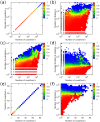Generalized friendship paradox in complex networks: the case of scientific collaboration
- PMID: 24714092
- PMCID: PMC3980335
- DOI: 10.1038/srep04603
Generalized friendship paradox in complex networks: the case of scientific collaboration
Abstract
The friendship paradox states that your friends have on average more friends than you have. Does the paradox "hold" for other individual characteristics like income or happiness? To address this question, we generalize the friendship paradox for arbitrary node characteristics in complex networks. By analyzing two coauthorship networks of Physical Review journals and Google Scholar profiles, we find that the generalized friendship paradox (GFP) holds at the individual and network levels for various characteristics, including the number of coauthors, the number of citations, and the number of publications. The origin of the GFP is shown to be rooted in positive correlations between degree and characteristics. As a fruitful application of the GFP, we suggest effective and efficient sampling methods for identifying high characteristic nodes in large-scale networks. Our study on the GFP can shed lights on understanding the interplay between network structure and node characteristics in complex networks.
Figures



References
-
- Watts D. J. & Strogatz S. H. Collective dynamics of ‘small-world’ networks. Nature 393, 440–442 (1998). - PubMed
-
- Castello C., Fortunato S. & Loreto V. Statistical physics of social dynamics. Rev. Mod. Phys. 81, 591–646 (2009).
-
- Vespignani A. Modelling dynamical processes in complex socio-technical systems. Nat. Phy. 8, 32–39 (2011).
-
- Centola D. The spread of behavior in an online social network experiment. Science 329, 1194–1197 (2010). - PubMed
Publication types
MeSH terms
LinkOut - more resources
Full Text Sources
Other Literature Sources
Medical
Research Materials

